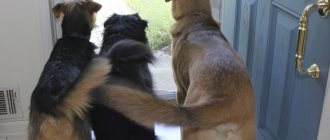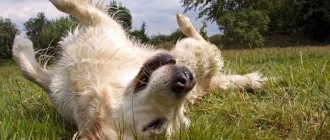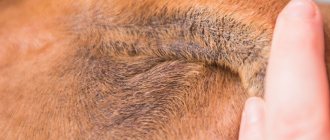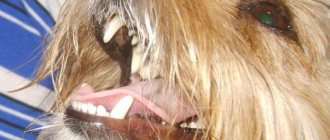Almost all dog owners have noticed how their four-legged friend tries the grass for a tooth while walking. Some people won’t pay attention to this, but others will worry – is the pet really lacking vitamins or is there something wrong with its health? It is still advisable to understand why a dog often eats grass, when it is safe, and when it will cause harm.
Why does a dog eat grass?
There are several reasons why a dog eats grass. You can get acquainted with them below.
Lack of fiber
If an animal eats an unbalanced diet, it suffers from a lack of fiber. This element is necessary for the quadruped for the normal functioning of the entire organism. According to observations, dogs whose owners feed high-quality food chew plants less often or do not pay attention to them at all.
Stomach cleansing
With a large amount of food, your pet may experience stomach discomfort. By eating greens, the weevil tries to induce vomiting and empty its stomach. Don't be alarmed if your dog eats grass and vomits it. But sound the alarm if your dog vomits several times after eating greens.
I like the taste
Our smaller brothers also have their own taste preferences, which can sometimes be strange. Some dogs just love the taste of greens. Therefore, in this case, a dog eating grass should not be alarming.
Play, especially in puppies
In puppyhood, dogs actively explore the world; they, like human children, want to put everything in their mouths. The puppy is also very interested in what every object that surrounds him tastes like.
Probable disease
The four-legged dog feels bad due to a number of diseases, so if the dog eats grass, it means that it wants to alleviate its condition a little. Observe your pet: does he show any other signs of illness (lack of appetite, lethargy, problems with bowel movements, etc.)?
Do not prevent your animal from eating outdoor vegetation if it feels fine afterwards. But pay attention if your pet eats greens too greedily. Sometimes owners may believe that their pet is so plaintively asking to go outside because it wants to go to the toilet.
But imagine their surprise when the pug runs headlong to a place overgrown with blades of grass and eats it like it was the last time. In this case, you better consult a veterinarian and ask him why the dog eats grass so frantically. It is quite possible that the dog liked the greens so much for a reason and will have to undergo a series of tests.
If your pet bothers you with its behavior while walking, try making adjustments to its diet first. Reduce the amount of meat, add more vegetables (except potatoes). Instead of cheap food that has virtually no vitamins and minerals, buy at least premium food.
Reasons why dogs eat grass
The fact that dogs vomit after eating grass is the main reason why they eat it. Dogs eat grass to cleanse their digestive system. The need for such cleaning arises for various reasons, including:
- To relieve feelings of nausea or other painful sensations that lead to nausea. After such a “herbal” procedure, the animal feels much lighter.
- To relieve pain and discomfort that may be caused by bloating.
- For the treatment of gastrointestinal disorders.
- To dilute stagnation in the intestines, which may occur due to disruption of the animal’s digestive system.
- To relieve general ill health caused by viruses and bacteria.
If your pet is not feeling well due to any of the above reasons, as well as other indicators such as stress, they will also eat grass.
This helps to normalize the general condition of the animal. Sometimes an animal needs grass so much that it begins to behave very excited and restless. You may get the impression that the dog is asking to go to the toilet, but when you let it out into the street, the animal often begins to greedily swallow grass. Both dogs and people can experience stomach problems caused by bloating. The difference is that in dogs such problems can occur 2-3 times a year. This is generally considered normal and should not cause you concern. However, if your pet is often depressed and often eats grass to trigger the gag reflex, it is best for you to seek professional advice from your veterinarian. In addition, you should know that dogs sometimes eat grass not only to induce burping, but even just because, maybe they just like it.
Dogs, by and large, are very selective about grass. They don't eat just anything. The animal will look for exactly the grass that it likes. Usually their choice is tall, broad-leaved grass.
What grass can dogs eat?
Now it has become a little clearer why dogs eat grass and why they behave a little strangely. Now we need to find out which greenfinch can be safely eaten by weevils.
Most plants do not pose a threat to pets, but this does not mean that you can allow your ward to eat whatever he wants.
Here is a list of what the wet nose can safely eat:
- sow thistle;
- wheatgrass;
- nettle;
- Rowan;
- chamomile;
- calendula;
- beet or carrot tops;
- mint, dill, parsley;
- rose hip;
- milk thistle;
- linden flowers;
- Valerina;
- dandelion;
- sprouted rye, wheat and oats.
It is very important that the plants grow in an environmentally friendly place away from roads and factories - and are not treated with chemicals. Only then will it be safe for your dog to eat grass.
Which grass is better?
There is no clear answer to the question. If your dog eats grass, make sure the animal chooses plants that are safe and non-poisonous.
Veterinarians recommend:
- cereal wild plants;
- wheat and oats;
- carrots, nettles, calendula, lettuce and beets.
What grass do dogs eat? Four-legged animals like mint, basil, parsley, dill and sorrel. Suitable greens for cats are those sold in pet stores. It is enough to purchase seeds, plant them, and at any time of the year you will have environmentally friendly greens.
What plants are dangerous?
When asked if dogs can eat grass, all veterinarians will tell you yes. But not just any plant will do. Adults usually feel that eating greens will make them feel bad, so they don’t risk trying them. But puppies and young animals may eat it purely out of curiosity.
The list of dangerous plants includes:
- horse chestnut;
- lupine;
- buttercup;
- buckwheat;
- poppy;
- clover;
- iris;
- horsetail;
- cornflowers;
- alfalfa;
- belladonna;
- henbane black.
If your pet does ingest a poisonous plant, you need to neutralize the poison as quickly as possible. It will be better if you take your four-legged animal to the veterinary clinic without delay.
But even if the wet-nose has eaten non-hazardous vegetation, there is a risk of infection by parasites, since there may be excrement of other animals on the surface of the greenery.
Are all herbs good for dogs?
Pets are smart creatures and they themselves understand which grass is good for them and which is not. But caution will not be superfluous, because we are talking about the health of the animal. A natural vitamin salad is useful, which consists of the following types of greens:
- wild cereal plants;
- oats and wheat;
- nettle;
- calendula;
- lettuce leaves;
- carrot and beet tops.
Dogs can safely be allowed to eat garden herbs - mint, dill, sorrel, parsley, basil. Chamomile relieves inflammation of the stomach and eliminates intestinal spasms. Nothing bad will happen if your pet eats burdock leaves. This plant is a good blood purifier, in addition, it is useful for the prevention of cancer.
In the summer, while walking in the forest, you shouldn’t miss every bush and blade of grass; the main thing is to monitor your pet’s health and, if there are signs of poisoning (diarrhea, refusal to eat, weight loss, lethargy, deterioration in coat quality), show it to the veterinarian.
But there are plants that are dangerous for animals. They should be avoided, and if the dog still manages to chew the blades of grass, take all measures to neutralize the toxins contained in them. The list of such plants is impressive, it includes:
- alfalfa;
- belladonna;
- black henbane;
- iris;
- lupine;
- horse chestnut;
- buckwheat;
- buttercup;
- celandine;
- chives, or chives;
- clover;
- horsetail;
- poppy;
- cornflower and others.
Some plants contain milky sap, which irritates the mucous membranes and skin and can cause burns, while others - such as celandine or belladonna - contain strong poisons. One leaf eaten can cause cardiac arrest in an animal. Plants of the nightshade family can cause nausea and vomiting and lead to dysfunction of the digestive system.
Herbal medicine for four-legged animals
Not only people are treated with herbs - they are ideal as a gentle therapy for dogs. In some cases, herbs can help faster and more effectively than medications. However, the appropriateness of such treatment must be confirmed by a veterinarian. If a four-legged animal is diagnosed with a serious illness, then traditional medicine fades into the background.
Non-dangerous sores can easily be cured with herbs, but only if you are sure that they will help your animal. Under no circumstances should you give plants that you are not sure are safe. If some infusion or mixture helped you, this does not mean that it will help your dog.
If your pet loves to eat street vegetation, try to walk it away from the roads. It will be much better if you start growing greenflies for your pet yourself. At least you will be sure that it is clean and safe, and if the dog is used to eating grass outside, he will probably stop doing it.
Way out of this situation
Why does a dog eat grass and then vomit? This question torments every dog breeder who has at least once encountered this situation. In most cases, the owner himself is to blame. An unbalanced diet causes too much mucus to accumulate in your pet's stomach. Hard blades of grass allow you to free the organ from unnecessary things. In the wild, the canine body is structured somewhat differently. Due to the fact that they hunt, partially digested fiber is also included in the food along with the meat. This causes the wild dog to regurgitate constantly to keep inedible scraps, mucus and debris from remaining in the stomach.
So, let's figure out why a dog eats grass and then vomits? If your pet’s diet includes too much boiled or fatty food, and does not include vegetables and fiber at all, then you should contact a specialist to balance your pet’s diet. Increased secretion of bile, irritation of the gastric mucosa, increased acidity, and as a result, the development of ulcers, leads to serious diseases. At first, the pet is looking for a way to get rid of stomach discomfort, so the dog constantly eats grass and regurgitates. If this happens too often, you should consult your veterinarian for advice.
If a pet finds grass on the street, eats it, and then vomits foam, and in addition to these symptoms there are a number of others, this is an important reason to urgently consult a doctor. Additional symptoms include:
- lethargy and drooping mood of the pet;
- dull coat;
- the appearance of loose stools;
- increase or decrease in temperature;
- the presence of blood in the vomit;
- dry nose;
- pallor or yellowness of the mucous membranes of the mouth and eyes.
Why is this happening? Probably because diseases such as gastritis, poisoning or infection are possible.
So, if your pet is looking for vegetation that can be chewed without harm to health, then which grass to choose and where to go for a walk? As a rule, pets “like” grasses (wheatgrass, sow thistle, bluegrass, grasses with rough leaves) growing in the meadow. Some dogs love to eat carrot, beet, and lettuce leaves. Cornflowers and calendula will be left without their heads. It is very important that the grass outside is not treated with pesticides. It is important that walks take place in areas located away from highways, since heavy metals tend to settle on plants. In this case, an activity that is beneficial to the body will turn into saving a poisoned dog.
When should you contact a veterinarian?
If a four-legged animal ate green grass and remained just as active and restless after that, then there is no danger.
However, if he chewed vegetation and then vomited repeatedly, you should run to the vet immediately. Most likely, what was eaten was poisonous or toxic. The veterinarian will neutralize the effect of the poison and prescribe the correct treatment.
You should also sound the alarm if you observe the following symptoms after your dog eats grass:
- refusal to eat;
- lethargy, apathy, reluctance to do anything;
- elevated temperature;
- convulsions;
- blueness of mucous membranes;
- there is blood in the stool and vomit;
- constipation for a long time;
- constant diarrhea;
- sudden weight loss;
- change in coat (too hard, starting to shed heavily, excessively tousled, etc.);
- repeated vomiting.
These signs may indicate dangerous infectious diseases or poisoning. You definitely can’t do this without visiting a specialist.
Medicinal properties of the plant
I know that in winter, nettle can be useful in cooking - for preparing various dishes, in cosmetology - for washing, treating dandruff and strengthening hair roots. It is used as fertilizer to feed plants.
But I won’t write much about the medicinal properties of nettle - there is more information on the Internet than even I know. But I will list the most useful qualities and uses of the plant:
- perfectly increases the body's defenses and improves resistance to colds;
- improves blood clotting and stops severe bleeding;
- has a remarkable effect on metabolic processes - improves appetite, quickly starts the process of cell rejuvenation and allows you to delay the aging of the body;
- It has been observed that nettle reduces muscle and joint pain;
- Unnoticed by the body, it removes toxins and waste, promotes its cleansing;
- has a calming effect on the nervous system and helps get rid of sleep problems.
All of the above properties have a positive effect not only on the human body, but also on animals, so nettle is very useful for dogs. You can give it all year round, dried or fresh, to animals. Dogs - up to 15 grams per day, cats - up to ten, chickens - no more than two grams. Young nettles contain a lot of vitamin C, and even more vitamin A than carrots.
The plant has anti-inflammatory, wound-healing, hemostatic properties. Nettle can restore normal hemoglobin levels, so it is used for bleeding and anemia. The plant promotes the formation of milk in mammals.
In addition to the fact that we collect and prepare young nettles for the winter, we also collect them in brooms and dry them, and in the winter we hang them out so that the chickens peck, replenishing the deficiency of vitamins.
Folk recipes for nettle dishes are familiar to everyone. We add the plant to soups; the baked goods made with it are very tasty. Of course, we use it for various medicinal purposes. The spring one is considered the healthiest, so at this time of year you can add it to salads.
Analogs from a pet store
Sprouted seeds of cereals and other crops are often sold in pet stores. You can be completely confident in the safety of this greenery. And if your pet doesn’t like the grass, you don’t have to throw it away. Transplant it into a larger pot and use it as a decorative element in your home.
The consultants in the store will tell you which greenback will suit your four-legged friend. They will also advise you on this or that plant if your dog has any health problems.
It would be a good idea to buy greens at any supermarket. This is about:
- Celery: Its stalk has anti-inflammatory properties. Indispensable for older pets suffering from arthritis.
- Parsley: it is rich in manganese, phosphorus, calcium, potassium and folic acid, which is very necessary for the health of dogs. Parsley also helps prevent unpleasant odor from an animal's mouth.
- Dill: since dill has a specific taste, animals do not always agree to eat it. But dill helps increase appetite and improve the functioning of the digestive system and kidneys.
- Basil: It contains vitamins B2 and C, potassium, calcium, iron, folic acid and magnesium. Like dill, basil improves digestion and increases appetite. Some feed manufacturers add basil to their products.
Don't give your wet-nose greens unless you're sure he needs them. It is better to discuss this point with your veterinarian. As a useful additive, you can finely chop dill or parsley in small quantities and add it to the food.
The opinion of scientists and zoologists on this matter
Why does a dog eat grass outside? Probably because the body requires it. Often, veterinarians and zoologists use plants such as chamomile, sage, mint, valerian, and oak bark for treatment. These plants help alleviate the condition of various diseases, for example, when a pet vomits foam after eating.
Western scientists found out from observing 1,500 dogs that about 80% of pets eat grass on the street. And only 9% of them have some diseases that lead the pet to look for suitable greens. And the owners are tormented by questions: “Why is he looking for greens? Why does he spit up later? Should I take him to the vet? Is it dangerous that he eats plants and then vomits?” There are many questions. As a survey of dog breeders showed, it doesn’t matter what kind of grass dogs eat, they do it for no reason. Most pets do not have problems with vomiting; the grass they eat passes through the entire gastrointestinal tract and is eliminated naturally. Why ask the question: “Why does a dog eat grass and then vomit?” - if, at the same time, she does not experience other ailments.
Some doctors recommend taking a closer look at the dog’s behavior during a walk. It happens that they do not gnaw vegetation at all, but simply play with it. You need to make sure that the tops of flowers and debris of bushes are not located near the battlefield. If the owner plants something in his garden, the plant runs the risk of being dug up by a caring pet and becoming a dog’s toy. This may not be the answer to some questions, but the pet’s motivation in this case is completely unrelated to the state of its health.
The pet's energy and cheerfulness are the reason that everything is fine. Why prevent your pet from enjoying the taste of greens if nothing bothers him? Experienced doctors recommend growing clean and safe grass at home. It could be oats, wheat or wheatgrass. Then the owners will not need to worry about the health of the pet if the dog does not eat a lot of grass growing outside.
All land-based predators occasionally feast on grass, and dogs are no exception. In the wild, this behavior is not dangerous, but in urban environments, eating grass can cause significant harm to health. How to understand why a dog eats grass, and is it worth weaning your pet from this habit?
Many owners think that their pets (not only dogs, but also cats, rodents, birds, etc.) chew plants in order to:
- replenish the supply of vitamins and microelements;
- recover from illness;
- brush your teeth, remove the smell from your mouth.
Zoologists and veterinarians are skeptical about such theories. It's hard to imagine that a dog is embarrassed by its own mouth odor. It is even more naive to believe that a dog can diagnose itself and eat a certain herb that will cure the disease. It’s becoming clearer about vitamins - no matter what kind of grass dogs eat, the body almost does not absorb useful substances from such “food”. The stomach and intestines of predators are not adapted to digest grass; the predator’s gastrointestinal tract simply does not have the necessary enzymes for the breakdown and assimilation of greenfinch.
But the grass, especially wheatgrass, which is loved by all dogs, causes contraction of the stomach walls. Long, hard blades of grass irritate the mucous membrane, causing the stomach to contract convulsively. The swallowed grass entangles the food bolus, rotting in the stomach. Greens improve the flow of bile. Therefore, many pets, feeling discomfort, heaviness or pressure in the abdomen, go to graze. An experienced owner probably knows why his dogs eat grass and does not discourage such behavior. After chewing a little, dogs deliberately induce vomiting, getting rid of “garbage” and excess bile. Therefore, it is better not to go home immediately after “grazing” - walk a little more so that the contents of the stomach do not end up on the carpet.
The grass also provides fiber and moisture, which is necessary for constipation. After leaving the stomach, the greens, almost in their original form, enter the intestines, where they swell and bind feces. By irritating the mucous membrane, greens enhance peristalsis, i.e. it is easier for the intestines to move the contents to the exit. Therefore, the fact that a dog eats grass and swears is not a cause for concern. Of course, if this is a one-time occurrence, and there are no other symptoms of illness. But the cause of difficulties with defecation needs to be found out - worms, overfeeding, poor quality food, illness?
Causes
When a dog feels heaviness in the abdomen, it can eat plants when going for a walk. This is a completely normal and natural process. But it’s better to grow useful plants at home, in your garden, or at your dacha. Therefore, there is nothing risky in this habit; you just need to observe what the dog eats.
Let's look at the reasons why dogs eat grass:
- Stomach disorders. Nausea can help remove toxic substances from the body.
- Eating low quality foods. Due to a lack of vitamins, lack of vegetables in the diet.
- The animal clears its stomach of hairballs.
- The pet chooses a certain type of plant. This may indicate a specific disease.
- If you have a sedentary lifestyle, grass can help speed up the passage of food through the digestive tract.
A dog may eat grass due to stomach problems.











